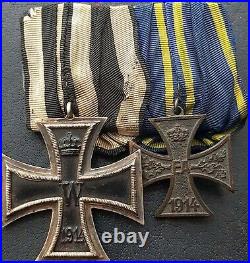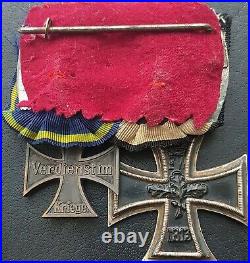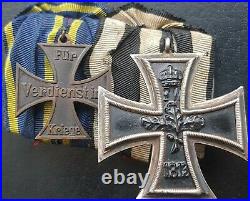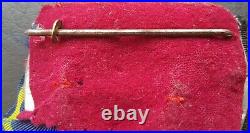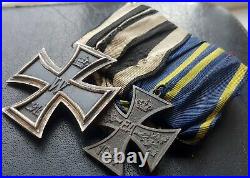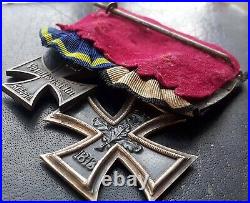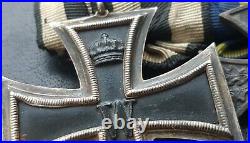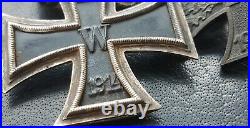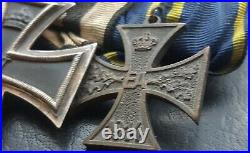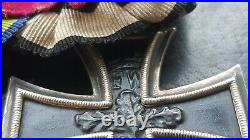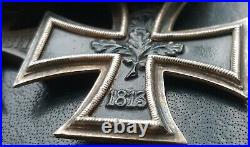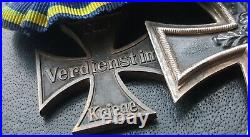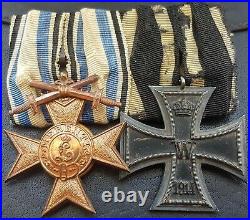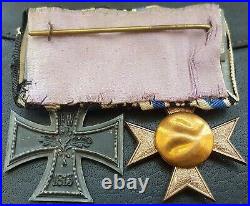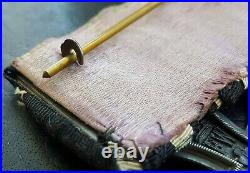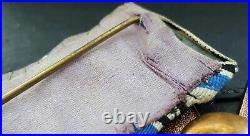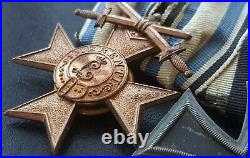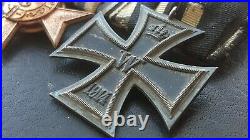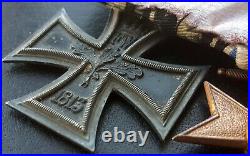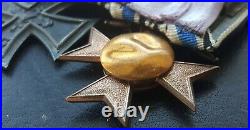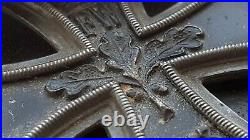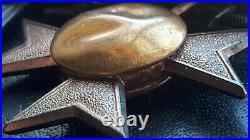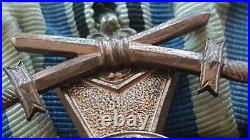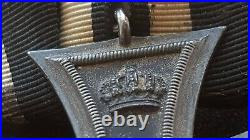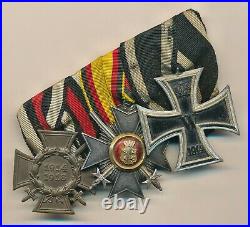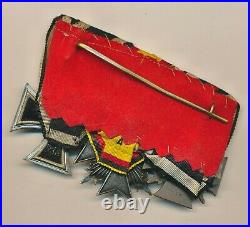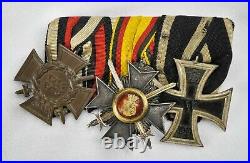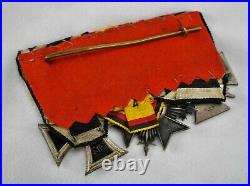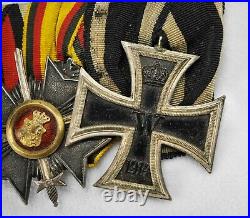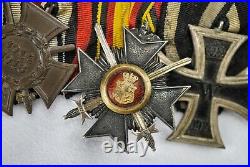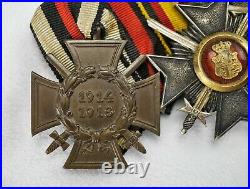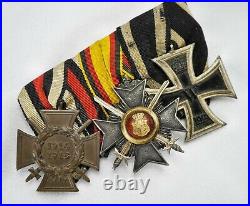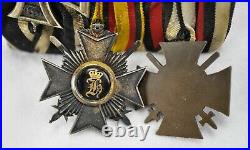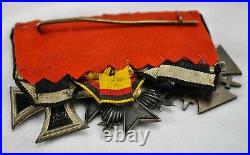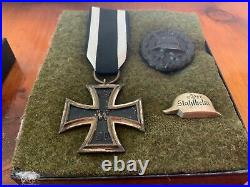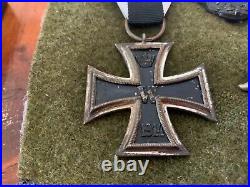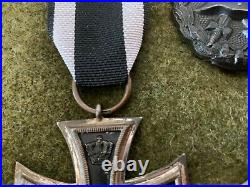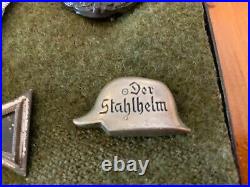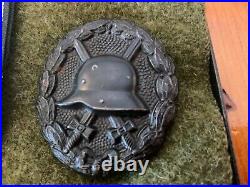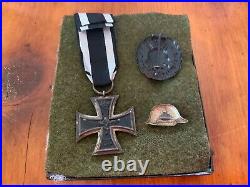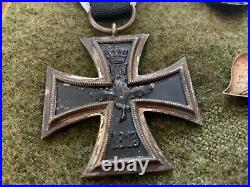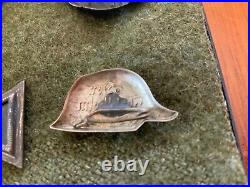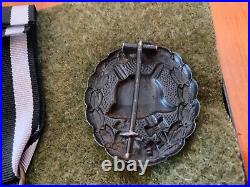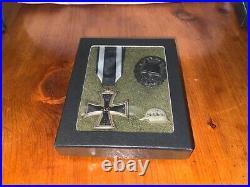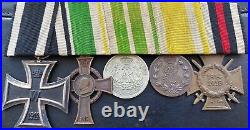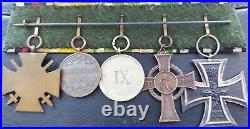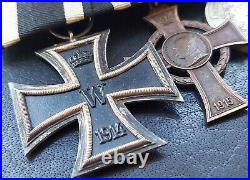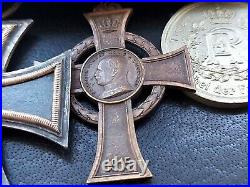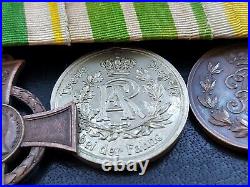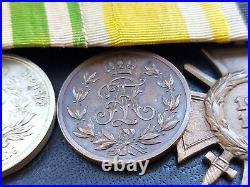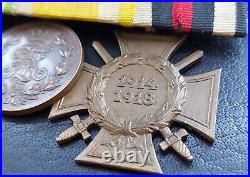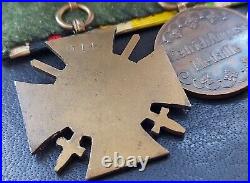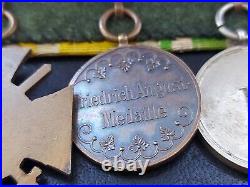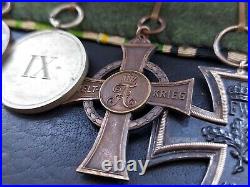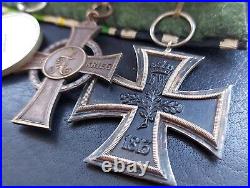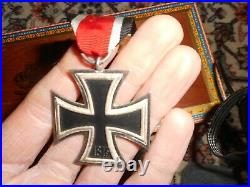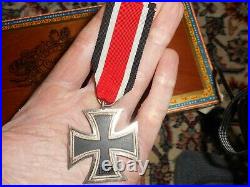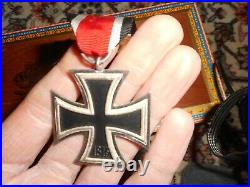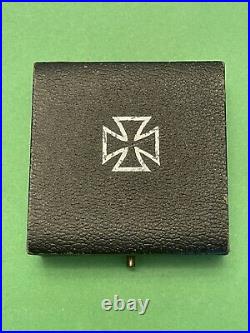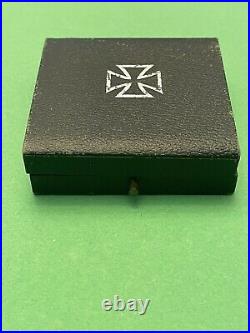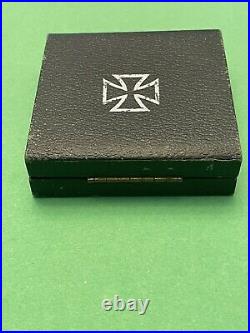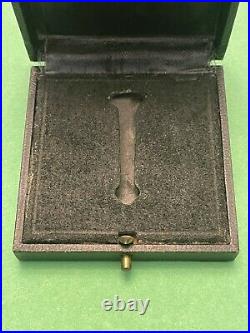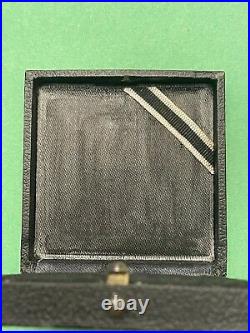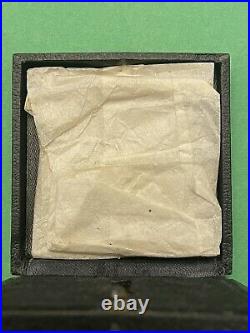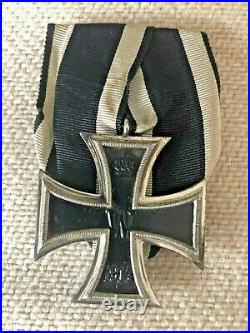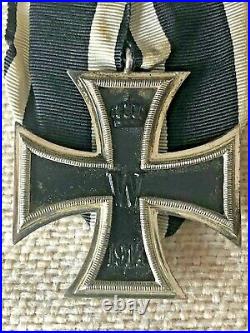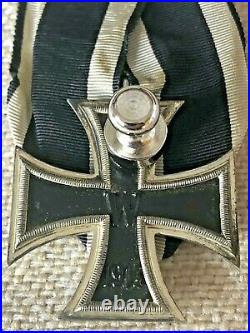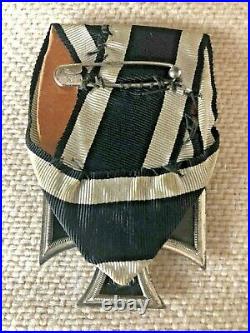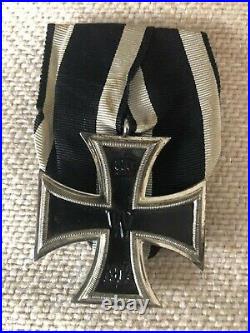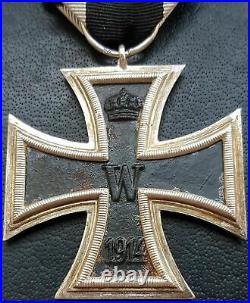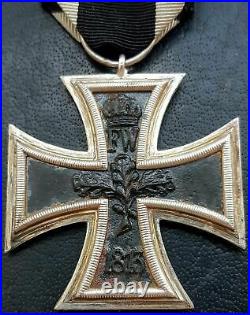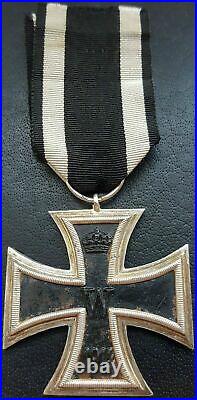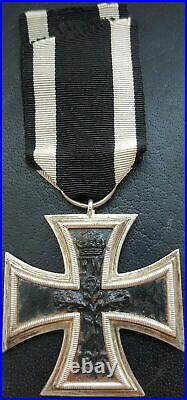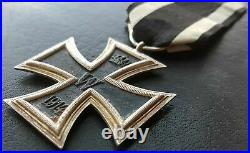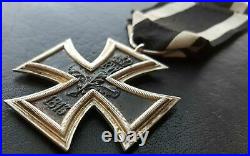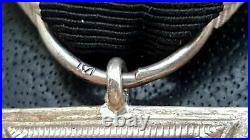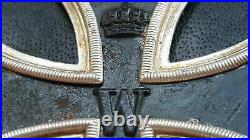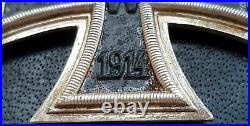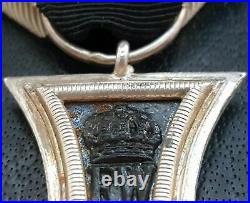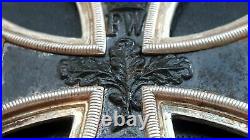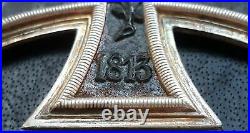Original WW1 German / Bavarian mounted medal group: Prussian Iron Cross II. Class & Bavarian War Merit Cross with Swords III. Class, IN NICE CONDITION, GENUINE RIBBONS, PERFECT PIN DEVICE, THE BACK OF THE BAVARIAN CROSS SEEMS TO BE LOST / DAMAGED AND REPLACED WITH A COPPER PLATE / BUTTON, A REALLY INTERESTING SMALL MEDAL GROUPING. HISTORY OF THE AWARDS. Iron Cross (German: Eisernes Kreuz) was a military decoration of the Kingdom of Prussia, and later of Germany, which was established by King Friedrich Wilhelm III of Prussia and first awarded on 10 March 1813 in Breslau. In addition to during the Napoleonic Wars, the Iron Cross was awarded during the Franco-German War, the First World War, and the Second World War. The Iron Cross was normally a military decoration only, though there were instances of it being awarded to civilians for performing military functions. Two examples, the civilian pilot Hanna Reitsch was awarded the Iron Cross First Class for her bravery as a test pilot during the Second World War and Melitta Schenk Gräfin von Stauffenberg (also a German female test pilot) was awarded the Iron Cross Second Class. The Iron Cross was also used as the symbol of the German Army from 1871 to 1915, when it was replaced by a simpler Greek cross. In 1956, the Iron Cross became the symbol of the Bundeswehr, the German armed forces. The traditional design is black and this design is used on armored vehicles and aircraft. A newer design in blue and silver is used as the emblem in other contexts. The Iron Cross is a black four-pointed cross with white trim, with the arms widening towards the ends, similar to a cross pattée. It was designed by the neoclassical architect Karl Friedrich Schinkel and reflects the cross borne by the Teutonic Knights in the 14th century. The ribbon for the 1813, 1870 and 1914 Iron Cross (2nd Class) was black with two thin white bands, the colours of Prussia. The noncombatant version of this award had the same medal, but the black and white colours on the ribbon were reversed. Initially the Iron Cross was worn with the blank side out. This did not change until 1838 when the sprig facing could be presented. Since the Iron Cross was issued over several different periods of German history, it was annotated with the year indicating the era in which it was issued. For example, an Iron Cross from the First World War bears the year “1914″, while the same decoration from the Second World War is annotated “1939″. The reverse of the 1870, 1914 and 1939 series of Iron Crosses have the year “1813″ appearing on the lower arm, symbolizing the year the award was created. The 1813 decoration also has the initials “FW” for King Frederick William III, while the next two have a “W” for the respective kaisers, Wilhelm I and Wilhelm II. The final version shows a swastika. It was also possible for a holder of the 1914 Iron Cross to be awarded a second or higher grade of the 1939 Iron Cross. In such cases, a “1939 Clasp” (Spange) would be worn on the original 1914 Iron Cross. A similar award was made in 1914 but was quite rare, since there were few in service who held the 1870 Iron Cross. For the First Class award the Spange appears as an eagle with the date “1939″ that was pinned above the Cross. Although two separate awards, in some cases the holders soldered them together. A cross was the symbol of the Teutonic Knights (a heraldic cross pattée), and the cross design (but not the specific decoration) has been the symbol of Germany’s armed forces (now the Bundeswehr) since 1871. The Iron Cross was founded on 10 March 1813 in Breslau and awarded to soldiers during the Wars of Liberation against Napoleon. It was first awarded to Karl August Ferdinand von Borcke on 21 April 1813. King Wilhelm I of Prussia authorized further awards on 19 July 1870, during the Franco-German War. The Iron Cross was reauthorized by Emperor Wilhelm II on 5 August 1914, at the start of the First World War. During these three periods, the Iron Cross was an award of the Kingdom of Prussia, although given Prussia’s pre-eminent place in the German Empire formed in 1871, it tended to be treated as a generic German decoration. The 1813, 1870, and 1914 Iron Crosses had three grades: Iron Cross 2nd Class German: Eisernes Kreuz 2. Klasse, Iron Cross 1st Class German: Eisernes Kreuz 1. Klasse, Grand Cross of the Iron Cross (German: Großkreuz des Eisernen Kreuzes, often simply Großkreuz). Although the medals of each class were identical, the manner in which each was worn differed. Employing a pin or screw posts on the back of the medal, the Iron Cross First Class was worn on the left side of the recipient’s uniform. The Grand Cross and the Iron Cross Second Class were suspended from different ribbons. The Grand Cross was intended for senior generals of the German Army. An even higher decoration, the Star of the Grand Cross of the Iron Cross, was awarded only twice, to Field Marshal Gebhard von Blücher in 1813 and to Field Marshal Paul von Hindenburg in 1918. A third award was planned for the most successful German general during the Second World War, but was not made after the defeat of Germany in 1945. The Iron Cross 1st Class and the Iron Cross 2nd Class were awarded without regard to rank. One had to already possess the 2nd Class in order to receive the 1st Class (though in some cases both could be awarded simultaneously). The egalitarian nature of this award contrasted with those of most other German states (and indeed many other European monarchies), where military decorations were awarded based on the rank of the recipient. For example, Bavarian officers received various grades of that Kingdom’s Military Merit Order (Militär-Verdienstorden), while enlisted men received various grades of the Military Merit Cross (Militär-Verdienstkreuz). Prussia did have other orders and medals which were awarded on the basis of rank, and even though the Iron Cross was intended to be awarded without regard to rank, officers and NCOs were more likely to receive it than junior enlisted soldiers. In the First World War, approximately four million Iron Crosses of the lower grade (2nd Class) were issued, as well as around 145,000 of the higher grade (1st Class). Exact numbers of awards are not known, since the Prussian archives were destroyed during the Second World War. The multitude of awards reduced the status and reputation of the decoration. Among the holders of the 1914 Iron Cross 2nd Class and 1st Class was Adolf Hitler, who held the rank of Gefreiter. Hitler can be seen wearing the award on his left breast, as was standard, in many photographs. The straight-armed Balkenkreuz, the emblem of the Wehrmacht, first used in a narrower form on Luftstreitkräfte aircraft in mid-April 1918, and as shown here, as it appeared on German planes, tanks, and other vehicles during the Second World War. Adolf Hitler restored the Iron Cross in 1939 as a German decoration (rather than Prussian as in earlier versions), continuing the tradition of issuing it in various grades. Legally it is based on the enactment Reichsgesetzblatt I S. 1573 of 1 September 1939 Verordnung über die Erneuerung des Eisernen Kreuzes (Regulation for the Re-introduction of the Iron Cross). The Iron Cross of the Second World War was divided into three main series of decorations with an intermediate category, the Knight’s Cross, instituted between the lowest, the Iron Cross, and the highest, the Grand Cross. The Knight’s Cross replaced the Prussian Pour le Mérite or “Blue Max”. Hitler did not care for the Pour le Mérite, as it was a Prussian order that could be awarded only to officers. The ribbon of the medal (2nd class and Knight’s Cross) was different from the earlier Iron Crosses in that the color red was used in addition to the traditional black and white (black and white were the colours of Prussia, while black, white, and red were the colors of Germany). Hitler also created the War Merit Cross as a replacement for the non-combatant version of the Iron Cross. It also appeared on certain Nazi flags in the upper left corner. The edges were curved, like most original iron crosses. The standard 1939 Iron Cross was issued in the following two grades: Iron Cross 2nd Class Eisernes Kreuz 2. Klasse, Iron Cross 1st Class Eisernes Kreuz 1. Klasse abbreviated as EKI or E. The Iron Cross was awarded for bravery in battle as well as other military contributions in a battlefield environment. The Iron Cross 2nd Class came with a ribbon and was worn in one of two different methods: when in formal dress, the entire cross was worn mounted alone or as part of a medal bar, for everyday wear, only the ribbon was worn from the second hole in the tunic button. The Iron Cross First Class was a pin-on medal with no ribbon and was worn centered on a uniform breast pocket, either on dress uniforms or everyday outfit. It was a progressive award, with the second class having to be earned before the first class and so on for the higher degrees. It is estimated that some four and a half million Second Class Iron Crosses were awarded in the Second World War, and 300,000 of the First Class. Bavarian Military Merit Cross (Militär-Verdienstkreuz) was that kingdom’s main decoration for bravery and military merit for enlisted soldiers. It was intended to reward extraordinary merit by non-commissioned officers, soldiers, and lower-ranking officials. It was originally established on July 19, 1866 as the 5th Class of the Military Merit Order, which was the main decoration for bravery and military merit for officers and higher-ranking officials. Civilians acting in support of the army were also made eligible for the decoration. The Military Merit Cross ranked after the Gold and Silver Military Merit Medals (renamed the Bravery Medals in 1918), which were Bavaria’s highest military honors for NCOs and enlisted soldiers. The cross was a Maltese cross with a center medallion. The obverse of the center medallion had an “L” cipher of King Ludwig II in the center and the word “MERENTI” on the ring. The reverse had a Bavarian lion with the date of founding, “1866″, on the ring. The center medallion was enameled (the original Military Merit Cross was distinguished from the Knight 2nd Class of the Military Merit Order only by having silver instead of blue enameled arms). The first recipient appears to have been Gendarm Johann Winter, who received the Military Merit Cross in the Armee-Befehl (Army Order) of August 20, 1866 The Bavarian Military Merit Cross underwent three major revisions. In February 1891, awards with swords were authorized to distinguish wartime awards, whether for bravery or military merit, from peacetime awards. This was made retroactive for wartime awards from the Austro-Prussian War of 1866 and Franco-Prussian War of 1870-71. In 1905, the statutes of the Military Merit Order were revised and the Military Merit Cross was divided into two classes. The former Military Merit Cross became the Military Merit Cross 1st Class, and a new second class was created which had no enamel on the medallion. The distinction in classes was based on the rank of the recipient. In 1913, another revision of the statutes of the Military Merit Order divided the Military Merit Cross into three classes. The old non-enameled 2nd Class became the 3rd Class and was changed from silver to bronze. The old 1st Class became the 2nd Class. The new 1st Class was identical to the 2nd Class except that it was gilt rather than silver. In addition, all classes were authorized to be awarded with a crown. The crown could be used for a second award to an NCO or soldier who already had received a particular class and whose rank precluded award of a higher class, or to recognize greater merit. There were then effectively 12 combinations: 3 classes each with or without crown, and each with or without swords. This doubled when one takes into account that there were two possible ribbons, one for soldiers and one for officials (Beamtenband). World War I broke out the following year, and the Military Merit Cross became Bavaria’s main decoration for bravery and merit by enlisted soldiers in that war, roughly equivalent to Prussia’s Iron Cross (except unlike the Iron Cross, the classes of the Military Merit Cross were awarded based on rank). According to one source, the total number of awards of all classes was 380,976 [5]. Approximately 290,000 were of the 3rd Class with Swords and approximately 73,000 of the 3rd Class with Crown and Swords, the two lowest grades. The Military Merit Cross became obsolete with the fall of the German Empire and the Bavarian Kingdom in 1918, although the Bavarian government continued to process awards up to 1920. This item is in the category “Collectables\Militaria\World War II (1939-1945)\Medals/ Ribbons”. The seller is “a..anderson” and is located in this country: GB. This item can be shipped worldwide.
- Type: Medals & Ribbons
- Featured Refinements: Medal Group
